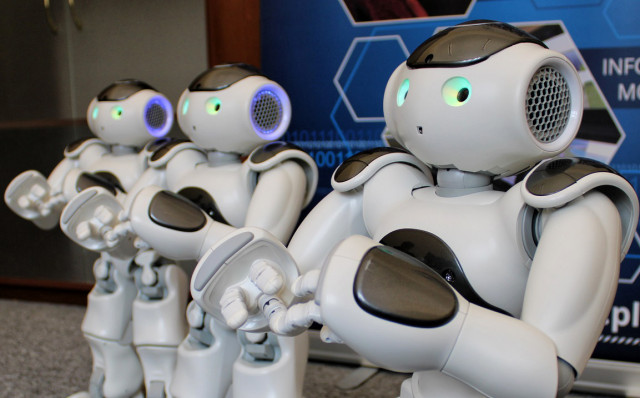We have four new humanoid robots in the laboratory at the Faculty of Computer Science and Telecommunications. Their capabilities have been tested by our researchers for several weeks.

Mija is the only girl in this group. Her name came from the first letters of our female staff at the Dean's office - Monika, Iza, Justyna. There are three boys next to Mija: WIitek - the name is given by Faculty of Computer Science and Telecommunications (pol. Wydział Informatyki i Telekomunikacji), AITek: name derived from IT and Telek (for Telecommunication).
All of them are designed and manufactured by Softbank.
Robots of this type are used primarily in hotels during check-in procedure, showing the way during events or at the shopping centres. They have a range of cameras, including 3D ones, a wide range of sensors including tactile ones. All are programmed in Java language.
The boys are type Nao v6 robots. Unlike Mija, they can walk. Mija uses wheels to move around. They have a range of sensors as well, including accelerometer, gyroscope, sonar, tactile sensors and cameras. Programmed in Python.

They are all capable to recognise what they see, they can move independently, follow the speaker and mimic human movements. They are equipped with imitating humans’ life mode, when the robot moves, changes positions, sometimes sigh and become curious about movement in the surrounding area, etc.
Who will need humanoids? Artificial intelligence and machine vision will be the basis for our graduate course we are developing at Computer Science Dept.
We would like our graduate programme to focus on human-robot and robot-robot communication, in particular, the development of automatic conversation systems, image recognition, object tracking, speech recognition systems. Robots will also be used to create new scientific solutions. Based on this commercial technology, our researchers will soon be able to develop original scientific projects.
Depending on how they are programmed - robots engage in conversations and answer questions. Mija loves to tell jokes: - "Computer programmer comes to the pharmacy and asks for vitamin C++".

Meanwhile, since the beginning of the year, the Faculty of Computer Science and Telecommunications staff have been exploring their possibilities, learning how to program them and familiarizing themselves with the world of robots. Are they afraid that robots will take over the Academy and then the world?
- I am not afraid of machine rebellion, these robots are very friendly individuals. I would be rather afraid of the programmers' madness. They are the potential risk factor! – Nozdrzykowski jokes.
At the Faculty of Computer Science and Telecommunications, you can currently choose between 2 subjects to study (in Polish): Computer Science and Teleinformatics
All of them are designed and manufactured by Softbank.
What can robots actually do?
Mija is a conversational robot (type Pepper), able to move on wheels, with a full range of hands gestures synchronised with speaking Polish and English. She has a large screen tablet for selecting options and data entry.Robots of this type are used primarily in hotels during check-in procedure, showing the way during events or at the shopping centres. They have a range of cameras, including 3D ones, a wide range of sensors including tactile ones. All are programmed in Java language.
The boys are type Nao v6 robots. Unlike Mija, they can walk. Mija uses wheels to move around. They have a range of sensors as well, including accelerometer, gyroscope, sonar, tactile sensors and cameras. Programmed in Python.

They are all capable to recognise what they see, they can move independently, follow the speaker and mimic human movements. They are equipped with imitating humans’ life mode, when the robot moves, changes positions, sometimes sigh and become curious about movement in the surrounding area, etc.
Why do we need them?
- Here at MUS, robots are part of the artificial intelligence and machine vision laboratory – says Łukasz Nozdrzykowski, PhD Eng., Vice-Rector for Education, Faculty of Computer Science and Telecommunications.Who will need humanoids? Artificial intelligence and machine vision will be the basis for our graduate course we are developing at Computer Science Dept.
We would like our graduate programme to focus on human-robot and robot-robot communication, in particular, the development of automatic conversation systems, image recognition, object tracking, speech recognition systems. Robots will also be used to create new scientific solutions. Based on this commercial technology, our researchers will soon be able to develop original scientific projects.
Depending on how they are programmed - robots engage in conversations and answer questions. Mija loves to tell jokes: - "Computer programmer comes to the pharmacy and asks for vitamin C++".
Meanwhile, since the beginning of the year, the Faculty of Computer Science and Telecommunications staff have been exploring their possibilities, learning how to program them and familiarizing themselves with the world of robots. Are they afraid that robots will take over the Academy and then the world?
- I am not afraid of machine rebellion, these robots are very friendly individuals. I would be rather afraid of the programmers' madness. They are the potential risk factor! – Nozdrzykowski jokes.
At the Faculty of Computer Science and Telecommunications, you can currently choose between 2 subjects to study (in Polish): Computer Science and Teleinformatics





